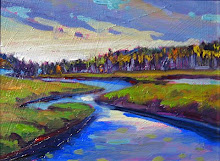

A.Y. Jackson, A Painter's Country, 1958, pages 59 and 66The Group of Seven painters were known for their love of travel and exploration of the Canadian land. Of all of the members of the Group, Jackson was the most widely traveled. A constant painter au plein air, he set up his easel from Vancouver Island to the Arctic to Nova Scotia. He explored his beloved home province of Quebec the most thoroughly of any region, painting the landscape, people and villages in all their many seasons, colours and moods. Baie Saint-Paul, on the north shore of the St. Lawrence River and north of Quebec City by some 62 miles, was a frequent destination. Several canvases resulted from his trips there, as well as numerous pencil drawings and a sketch-book, in the collection of the National Gallery of Canada. In these, the characteristic buildings with their quaint rooflines and simple, functional architecture were most often the subjects of his work. It was the charming lines of the buildings that appealed to Jackson; the contrast of the structural shapes with the rolling hills in the distance was the essence of simplicity and serenity. It was a place he called "Christmas card country", where one scene after another awaited his brush. Many of these buildings would be replaced shortly after Jackson painted them, a fact he acknowledges in his autobiography. In reference to the picturesqueness of Quebec, he wrote to Clarence Gagnon, who was in Paris at the time: "Why don't you come home and paint Quebec.There should be fifty artists working to record its fast vanishing charms..." This Group period Jackson masterpiece takes us back to a time now gone, and we feel invited to join the simple scene by the freshly laid track in the snow which winds its way to the snow-covered buildings. Fence posts poke through the deep snow, and some wood - perhaps a sled and some skis - rests against one of the outbuildings, hinting at ways we might travel the same track. The foreground and its buildings are warmed by the sun, while the distant landscape is cooler and in slight shadow. The snow is deep and full of colour, a play of various shades of white, lit by the thin band of sky showing through the low afternoon cloud. The brushwork in the scene is classic 1920s Jackson, smooth, fluid and assured. The shadows in the snow are deft and subtle, perfect swatches of blue and pink. Jackson is at the peak of his career, and is clearly at his most comfortable in such rural landscapes, with their rolling vistas and small hints of humanity. Snow had great appeal to Jackson in Baie Saint-Paul, and it was there that he acquired the nickname Père Raquette - Father Snowshoes. Baie Saint-Paul is known as an artist's paradise, attracting many painters to its majestic landscape and quaint village life. Clarence Gagnon and Edwin Holgate worked there repeatedly, and both Jean Paul Lemieux and Marc-Aurèle Fortin were attracted to its visual offerings. Jackson mentions the impending arrival of Lilias Torrence Newton, Albert Robinson and Mabel May in a letter to J.E.H. MacDonald written in January of 1924 from Baie Saint-Paul. Jackson's love of the small Quebec village remained constant in his long career, and he stated, "I do not know how many Quebec canvases I have painted. I have worked in villages on both the north and south shores of the Saint Lawrence. In thirty years I missed only one season.I have happy memories of a great many places." This magnificent painting captures a bygone era, depicting a lost way of life that Jackson has preserved for our nation's memory.
video of A.Y Jackson 's philosophy and process of working in Plein Aire









